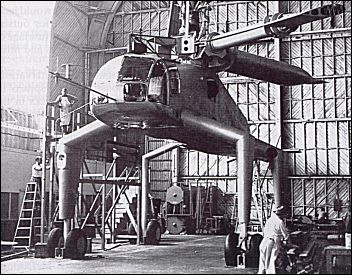
| Hughes XH-28 1981 |  |
 |

| Hughes XH-28 1981 |  |
 |
|
Development of a large helicopter was begun in January 1951 to meet an Army requirement for a flying crane capable of transporting combat-loaded military vehicles weighting up to 20 tons (18.1 tonnes). Like the XH-17 which was then about to be flown, the XH-28 was to use a pressure-jet system to drive the four-bladed main rotor, with two Allison XT40-A-8 turbines being geared to a compressor unit and compressed air dueled to burners at the tip of each blade. Weighing 23587kg empty and 47627kg loaded, the XH-28 was to have had enclosed accommodation for two pilots. Its four tall undercarriage units, each with dual-wheels would have given it a spider look while providing adequate clearance for outsize loads. These loads were to have been either slung beneath the fuselage or carried on a flat-bed attached between the undercarriage legs and fitted with a ramp for loading and unloading vehicles. The design was subjected to extensive wind-tunnel tests with various suspended loads, and a full-scale mock-up was constructed. In spite of its promising capability, the XH-28 was not built due to cutbacks in the research and development budget made near the end of the Korean War. Rene J. Francillon "McDonnell Douglas Aircraft since 1920: Volume II", 1997
|